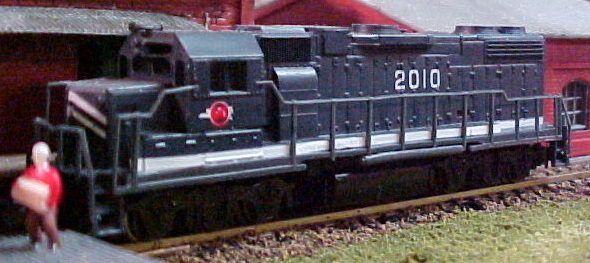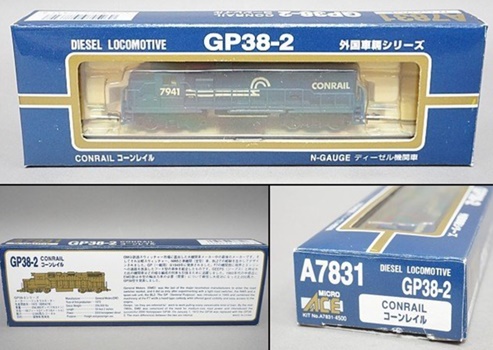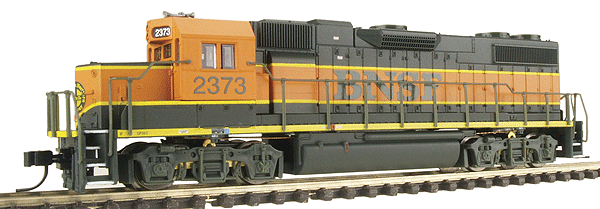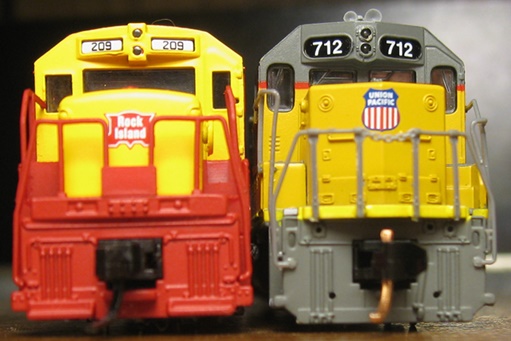

Introduced: 1988 (revised in 2006 and 2015)
As noted above, there have been three different versions of this model (so far). And although the second and third versions represent a considerable upgrade over the first, they're all respectable models. Also, Atlas purchased the Walthers (nee Life-Like) line of N scale models in 2018 and has announced new DCC-Sound equipped versions of this model for release in 2024.
The original 1988 release was the first in a series of nice looking, decent running and (most importantly) affordably priced Life-Like locomotive models (all manufactured in China). Throughout the 1990s, the same basic chassis design employed in this model would eventually be recycled (more or less) in numerous other "wallet friendly" Life-Like models - F7, F40PH, BL2, FA-2/FB-2, and GP18. It was a good niche for Life-Like at the time - filling the void between Bachmann's line of cheapie trainset junk and the nice-but-expensive offerings from Atlas and Kato.
Like the rest of Life-Like's early line of N scale locomotives, these models were also sold in Moki/Micro Ace packaging (and presumably not for the North American market) -

The chassis is all plastic and quite light. Ala-carte weights plunked atop each of the truck towers provide most of the model's weight. The 5-pole motor is open-sided and skew-wound. All eight wheels are geared and provide pickup (no traction tires). Current is transferred from the trucks to the motor via miles of wiring (two wires per truck). All gearing is plastic. The driveshafts are plastic with springs in the middle. Couplers are truck-mounted Rapidos (open pilots). A non-directional headlight sits atop the forward chassis weight. The wheels are blackened. They're also low-profile, so no problems on Code-55 track.

Of course, the models aren't even in the same ballpark as an Atlas or a Kato (either in looks or performance). But for what they were (affordable), they're quite respectable. They run relatively quietly, throttle response is smooth, pulling power is good, pickup is great (no stalls), and slow-speed creep is nice (although the top-end speed is off the charts). Shell detailing and paint are somewhat crude, but for what they cost (about a third the cost of an Atlas or Kato model of that era), they were a good value (especially as compared to some of the junk that Bachmann was selling at the time).
Prototypically speaking, these models are based on the "Phase 2" GP38-2 (as oppposed to the Atlas model, which is based on the "Phase 1" version). On the "rivet counting" front, I've read that this model has a number of inaccuracies - the main problem being its lack of a tell-tale Dash 2 water-level sight glass. However, this discrepency was eventually corrected in later runs by simply painting one on the shell -

Dummy units were also available (Life-Like sold a three unit set with one powered unit, one dummy unit and a matching caboose). This early "cheap" version was available up until around 2000, at which point Life-Like starting dropping all of their economically priced diesel models in favor of higher-end offerings.
An all-new version of this locomotive was released in 2006 -

The chassis design is similar in most respects to modern Atlas and Kato diesel models. Features include -
- Powerful 5-pole Motor with Skew Wound Armature and Dual Flywheels
- Split Frame Mechanism
- 8-Wheel Drive & 8-Wheel Pick-Up
- Accumate Operating Couplers (Rapido couplers included)
- Directional LED Headlight
- Includes snow plows and winterization hatches where appropriate (to be user installed).

The looks and performance of this new model are outstanding in every way (well, almost every way), and certainly right up there with Atlas and Kato diesels of similar vintage. These are super smooth and quiet runners with strong pulling power, and it's particularly nice to see these models finally available with full pilots and shell-mounted automatic couplers.
On the down side, they somehow managed to screw up the sight glass yet again. It was completely omitted on the first run, whereas second run units had them painted on once again. In addition to the sight glass problem, I've read various other complaints about minor shell issues ("the fans are too thick", "the radiator looks funny", "it's missing a roof overhang", "you can see the holes for mounting the winterization hatch", etc). And I guess if such things bother you, this model probably isn't going to make you happy (then again, if such things bother you, I'm assuming nothing will ever make you happy).
The marketing spiel for this second version includes claims about its supposedly "DCC Friendly" mechanism. Well, claims of "DCC Friendliness" aside, I certainly wouldn't categorize this locomotive as being "DCC Ready". Although the mechanism does have a PC board running along the top to operate the lights, there is no contact between the lightboard and the motor contacts (which, instead, contact the frame directly), so a simple drop-in decoder replacement for the PC board is not going to be an option with this second version.
The box labels between the first and second runs of this version differ significantly - with the first run coming in Life-Like boxes and the second coming in Walthers boxes. The catalog numbers for the first run are 75000 through 75016. Second run models are numbered 75017 through 75035.
This model was revised yet again in 2015 (sold in Walthers boxes with 50300-50312 catalog numbers), with the main change being full-on support for DCC. As pictured below, the lightboard was changed to include motor contacts, and the motor itself was isolated from the chassis -

In addition to the DCC-related changes, the couplers were changed over to Micro-Trains. Unfortunately for the rivet counters, the shell remained unchanged (still has winterization hatch holes, still has a painted-on sightglass, etc) -


Performance on this third version is every bit the equal of the second (IE, outstanding). The only minor issue I ran into with mine relates to its pilot. As pictured below, it sits perilously low and close to the rails (Atlas U25B included in the shot for comparison purposes) -


I don't know if they're all this way, but mine would actually scrape the rails when faced with any sort of unevenness in the track (a small dip or bump or whatever), resulting in an audible squeaking sound. Fortunately, sanding a little bit off the bottom of the pilot (not much more than the thickness of the paint) resolved the issue for me. So, ultimately not that big of a deal.
Trivia - Life-Like/Walthers GP38-2 shells will fit on the Atlas GP40 (et al) chassis, although not vice versa.
To remove the shell (all versions) insert a small screwdriver (or a toothpick or whatever) and carefully pry the shell away from the chassis. This will free the chassis clips (four of them) and allow the shell to pull off.
Grade: B (for the 1988 version) and A (for the revised versions)
First version reviewed: 3/89 Model Railroader ("This version... is made in China. The body shell is nicely detailed and checked out nearly perfect against the prototype drawings... One small but important detail is missing, the water-level sight glass on the right side of the long hood. This is the single most important spotting feature for distinguishing Dash 2 units from their earlier counterparts... Our sample Santa Fe unit was neatly, if just a bit heavily, painted. The scheme is true to the prototype, except that the rear end of the hood should be yellow and the trucks silver... Since Life-Like left off that sight glass, all you really have to do to convert this unit to a straight GP38 is use a sharp hobby knife to trim off the dampening strut on the right-hand journal boxes. Then add a second airbrake cylinder facing the one on the left... The frame is made out of plastic. Weight is provided in the form of two lead castings... along with another lead weight in the belly tank. The motor is an open-frame double-ended five-pole skewed-armature type, and it's attached to the frame with a screw... The trucks are plastic, and the wheels are chemically blackened. Electrical pickup is made by metal wipers rubbing against the backs of the wheels. Tiny wires complete the circuit to the motor and light. Our model ran with some noise and vibration when we first placed it on the test track, but its performance smoothed out steadily during the 3 to 4 minutes we ran it back and forth prior to testing. The GP38-2's pulling power is good despite the absence of rubber traction tires... To sum it up, this is a good-looking, decent-running locomotive, but it is neither as crisply detailed nor as smooth and quiet as Kato's. At the same time, its retail cost is less than half, and to my mind it's a good value. This engine should not be judged by Life-Like's past N scale offerings. The firm says that this is the first N scale locomotive they've developed from the ground up. It's their first in that scale with 8-wheel drive, and it has a bigger and better motor. This EMD GP38-2 certainly looks like a step in the right direction for Life-Like. BN, CSX or SF. Price: $22")